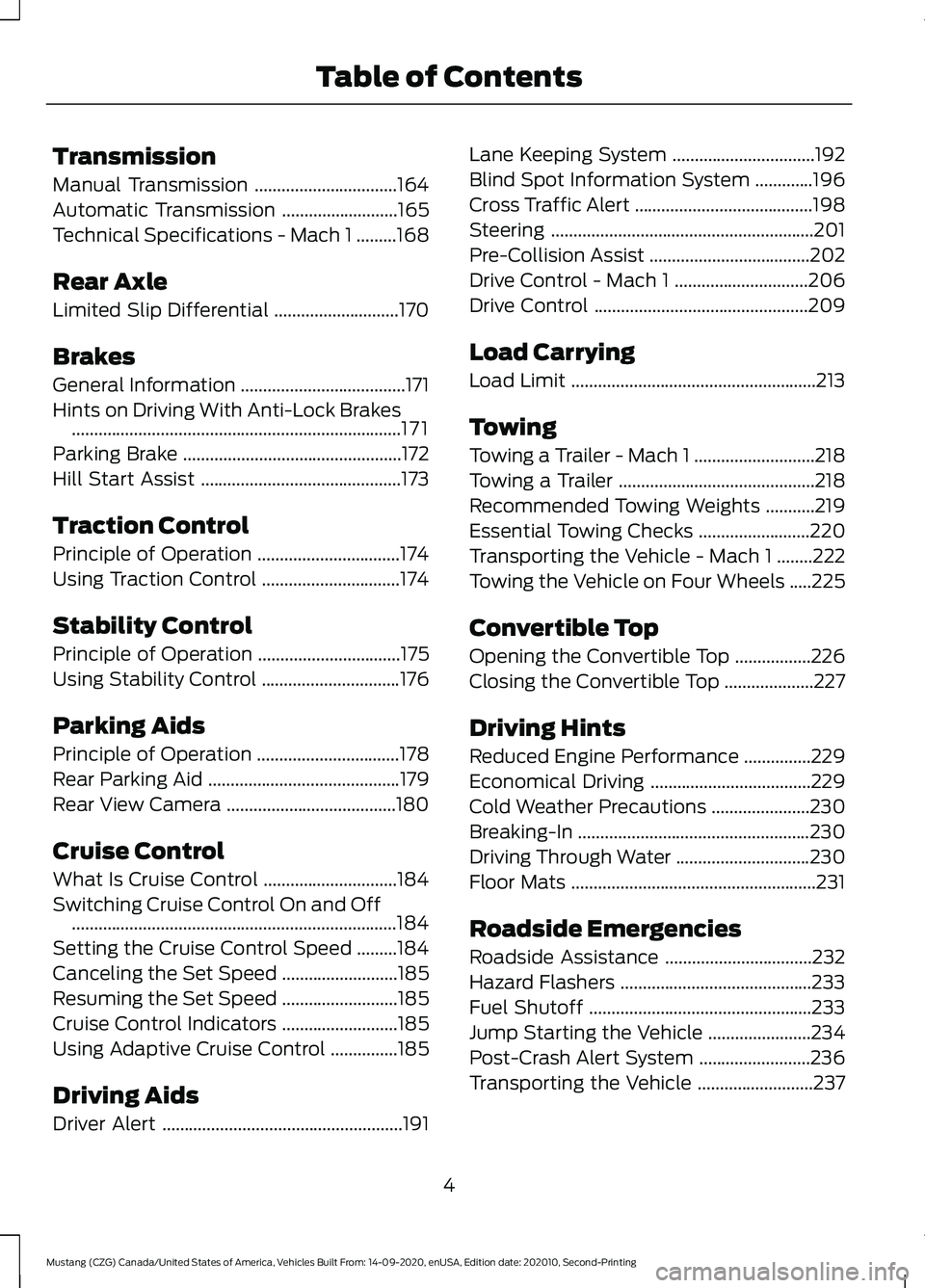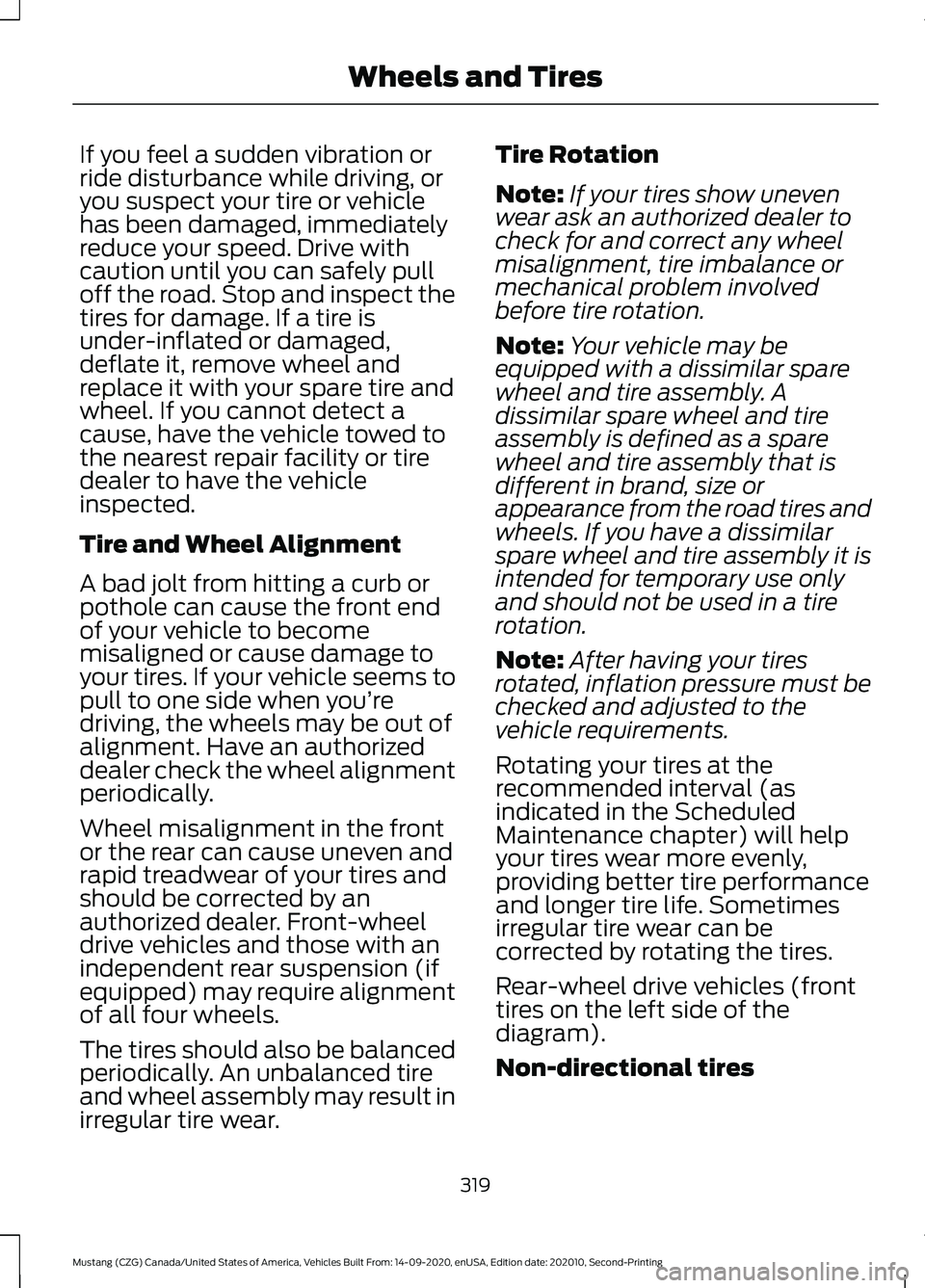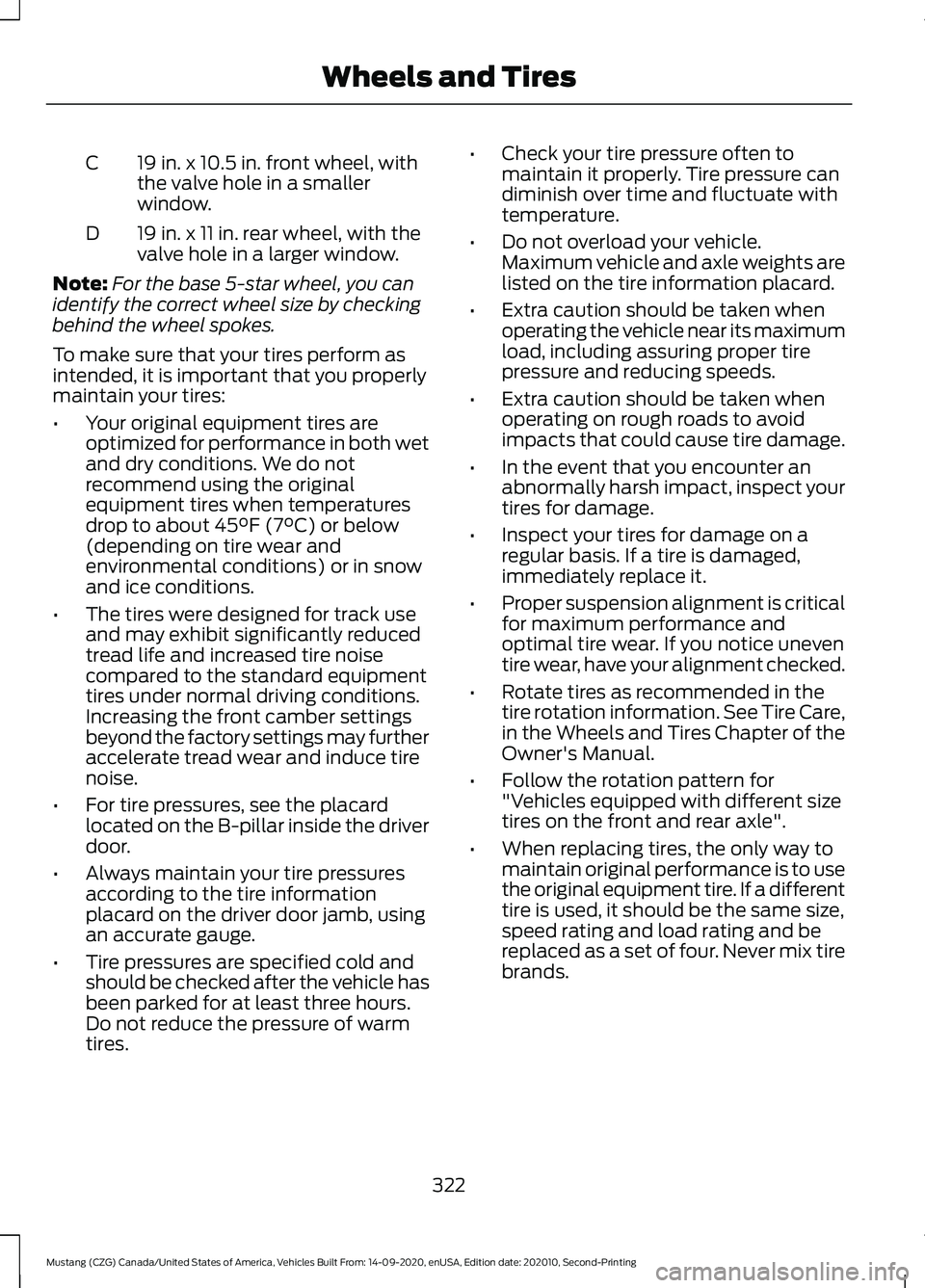four wheel drive FORD MUSTANG 2021 Owners Manual
[x] Cancel search | Manufacturer: FORD, Model Year: 2021, Model line: MUSTANG, Model: FORD MUSTANG 2021Pages: 530, PDF Size: 10.22 MB
Page 7 of 530

Transmission
Manual Transmission
................................164
Automatic Transmission ..........................
165
Technical Specifications - Mach 1 .........
168
Rear Axle
Limited Slip Differential ............................
170
Brakes
General Information .....................................
171
Hints on Driving With Anti-Lock Brakes ........................................................................\
..
171
Parking Brake .................................................
172
Hill Start Assist .............................................
173
Traction Control
Principle of Operation ................................
174
Using Traction Control ...............................
174
Stability Control
Principle of Operation ................................
175
Using Stability Control ...............................
176
Parking Aids
Principle of Operation ................................
178
Rear Parking Aid ...........................................
179
Rear View Camera ......................................
180
Cruise Control
What Is Cruise Control ..............................
184
Switching Cruise Control On and Off ........................................................................\
.
184
Setting the Cruise Control Speed .........
184
Canceling the Set Speed ..........................
185
Resuming the Set Speed ..........................
185
Cruise Control Indicators ..........................
185
Using Adaptive Cruise Control ...............
185
Driving Aids
Driver Alert ......................................................
191Lane Keeping System
................................
192
Blind Spot Information System .............
196
Cross Traffic Alert ........................................
198
Steering ...........................................................
201
Pre-Collision Assist ....................................
202
Drive Control - Mach 1 ..............................
206
Drive Control ................................................
209
Load Carrying
Load Limit .......................................................
213
Towing
Towing a Trailer - Mach 1 ...........................
218
Towing a Trailer ............................................
218
Recommended Towing Weights ...........
219
Essential Towing Checks .........................
220
Transporting the Vehicle - Mach 1 ........
222
Towing the Vehicle on Four Wheels .....
225
Convertible Top
Opening the Convertible Top .................
226
Closing the Convertible Top ....................
227
Driving Hints
Reduced Engine Performance ...............
229
Economical Driving ....................................
229
Cold Weather Precautions ......................
230
Breaking-In ....................................................
230
Driving Through Water ..............................
230
Floor Mats .......................................................
231
Roadside Emergencies
Roadside Assistance .................................
232
Hazard Flashers ...........................................
233
Fuel Shutoff ..................................................
233
Jump Starting the Vehicle .......................
234
Post-Crash Alert System .........................
236
Transporting the Vehicle ..........................
237
4
Mustang (CZG) Canada/United States of America, Vehicles Built From: 14-09-2020, enUSA, Edition date: 202010, Second-Printing Table of Contents
Page 279 of 530

TRACK USE - MACH 1
Operating at High Speeds and
Track Days
Your vehicle is capable of sustained high
speeds and track day driving.
Before operating your vehicle at high
speeds:
•
Verify your tires have the correct
pressures.
• Inspect wheels and tires for wear and
damage. Replace any damaged wheels
and tires.
• Check and set lug nut torque. See
Technical Specifications (page 334).
• Verify fluid levels for oil, coolant, brake
and hydraulic fluid. See
Capacities
and Specifications (page 335).
• Change the engine oil and replace the
engine oil filter prior to use on the track.
Change the engine oil and filter again
after every four hours of track time.
Maintain the engine oil level at or near
the max mark on the engine oil dipstick.
See
Engine Oil Check (page 261).
• Replace the brake fluid with fresh
Motorcraft/Ford DOT 4 LV High
Performance Brake Fluid or other DOT
compliant fluid with a dry boiling point
greater than
500°F (260°C) from a
sealed container. Do not use silicone
or DOT 5 brake fluids. •
If you are operating your Mach 1 on a
drag strip, use drag strip selectable
drive mode in addition to using line lock
and launch control to provide a specific
set-up tuned for the quickest straight
line elapsed times.
• If you are operating your Mach 1 on a
road course, use sport or track
selectable drive modes to provide a
specific set-up tuned for optimal shift
and suspension set-up that is tuned
towards handling prowess on closed
course surfaces.
After operating your vehicle at high speeds
or track day driving, do the following:
• Set the tire pressure to the proper
specification.
• Check and set the lug nut torque. See
Technical Specifications
(page 334).
• Check all fluid levels.
• Refer to the track maintenance interval
chart. See
Normal Scheduled
Maintenance (page 444).
• Check the front and rear wheel
bearings for abnormal wear.
• Inspect brake caliper dust boots for
abnormal wear.
Track Apps WARNING:
Track Apps™
is for
track use only. Remember that even
advanced technology cannot defy the
laws of physics. It is always possible to
lose control of a vehicle due to
inappropriate driver input for the
conditions. Aggressive driving on any
road condition can cause you to lose
control of your vehicle increasing the risk
of personal injury or property damage.
276
Mustang (CZG) Canada/United States of America, Vehicles Built From: 14-09-2020, enUSA, Edition date: 202010, Second-Printing Track Use
Page 312 of 530

G.
H: Indicates the tire's speed
rating. The speed rating denotes
the speed at which a tire is
designed to be driven for extended
periods of time under a standard
condition of load and inflation
pressure. The tires on your vehicle
may operate at different
conditions for load and inflation
pressure. These speed ratings may
need to be adjusted for the
difference in conditions. The
ratings range from
81 mph
(130 km/h) to 186 mph
(299 km/h). These ratings are
listed in the following chart.
Note: You may not find this
information on all tires because it
is not required by federal law. Speed rating - mph
(km/h)
Letter
rating
81 (130)
M
87 (140)
N
99 (159)
Q
106 (171)
R
112 (180)
S
118 (190)
T
124 (200)
U
130 (210)
H
149 (240)
V Speed rating - mph
(km/h)
Letter
rating
168 (270)
W
186 (299)
Y
Note: For tires with a maximum
speed capability over 149 mph
(240 km/h), tire manufacturers
sometimes use the letters ZR. For
those with a maximum speed
capability over 186 mph (299
km/h), tire manufacturers always
use the letters ZR.
H. U.S. DOT Tire Identification
Number (TIN):
This begins with
the letters DOT and indicates that
the tire meets all federal
standards. The next two numbers
or letters are the plant code
designating where it was
manufactured, the next two are
the tire size code and the last four
numbers represent the week and
year the tire was built. For
example, the numbers 317 mean
the 31st week of 1997. After 2000
the numbers go to four digits. For
example, 2501 means the 25th
week of 2001. The numbers in
between are identification codes
used for traceability. This
information is used to contact
customers if a tire defect requires
a recall.
I. M+S or M/S:
Mud and Snow, or
AT:
All Terrain, or
AS:
All Season.
309
Mustang (CZG) Canada/United States of America, Vehicles Built From: 14-09-2020, enUSA, Edition date: 202010, Second-Printing Wheels and Tires
Page 322 of 530

If you feel a sudden vibration or
ride disturbance while driving, or
you suspect your tire or vehicle
has been damaged, immediately
reduce your speed. Drive with
caution until you can safely pull
off the road. Stop and inspect the
tires for damage. If a tire is
under-inflated or damaged,
deflate it, remove wheel and
replace it with your spare tire and
wheel. If you cannot detect a
cause, have the vehicle towed to
the nearest repair facility or tire
dealer to have the vehicle
inspected.
Tire and Wheel Alignment
A bad jolt from hitting a curb or
pothole can cause the front end
of your vehicle to become
misaligned or cause damage to
your tires. If your vehicle seems to
pull to one side when you’re
driving, the wheels may be out of
alignment. Have an authorized
dealer check the wheel alignment
periodically.
Wheel misalignment in the front
or the rear can cause uneven and
rapid treadwear of your tires and
should be corrected by an
authorized dealer. Front-wheel
drive vehicles and those with an
independent rear suspension (if
equipped) may require alignment
of all four wheels.
The tires should also be balanced
periodically. An unbalanced tire
and wheel assembly may result in
irregular tire wear.
Tire Rotation
Note:
If your tires show uneven
wear ask an authorized dealer to
check for and correct any wheel
misalignment, tire imbalance or
mechanical problem involved
before tire rotation.
Note: Your vehicle may be
equipped with a dissimilar spare
wheel and tire assembly. A
dissimilar spare wheel and tire
assembly is defined as a spare
wheel and tire assembly that is
different in brand, size or
appearance from the road tires and
wheels. If you have a dissimilar
spare wheel and tire assembly it is
intended for temporary use only
and should not be used in a tire
rotation.
Note: After having your tires
rotated, inflation pressure must be
checked and adjusted to the
vehicle requirements.
Rotating your tires at the
recommended interval (as
indicated in the Scheduled
Maintenance chapter) will help
your tires wear more evenly,
providing better tire performance
and longer tire life. Sometimes
irregular tire wear can be
corrected by rotating the tires.
Rear-wheel drive vehicles (front
tires on the left side of the
diagram).
Non-directional tires
319
Mustang (CZG) Canada/United States of America, Vehicles Built From: 14-09-2020, enUSA, Edition date: 202010, Second-Printing Wheels and Tires
Page 325 of 530

19 in. x 10.5 in. front wheel, with
the valve hole in a smaller
window.
C
19 in. x 11 in. rear wheel, with the
valve hole in a larger window.
D
Note: For the base 5-star wheel, you can
identify the correct wheel size by checking
behind the wheel spokes.
To make sure that your tires perform as
intended, it is important that you properly
maintain your tires:
• Your original equipment tires are
optimized for performance in both wet
and dry conditions. We do not
recommend using the original
equipment tires when temperatures
drop to about 45°F (7°C) or below
(depending on tire wear and
environmental conditions) or in snow
and ice conditions.
• The tires were designed for track use
and may exhibit significantly reduced
tread life and increased tire noise
compared to the standard equipment
tires under normal driving conditions.
Increasing the front camber settings
beyond the factory settings may further
accelerate tread wear and induce tire
noise.
• For tire pressures, see the placard
located on the B-pillar inside the driver
door.
• Always maintain your tire pressures
according to the tire information
placard on the driver door jamb, using
an accurate gauge.
• Tire pressures are specified cold and
should be checked after the vehicle has
been parked for at least three hours.
Do not reduce the pressure of warm
tires. •
Check your tire pressure often to
maintain it properly. Tire pressure can
diminish over time and fluctuate with
temperature.
• Do not overload your vehicle.
Maximum vehicle and axle weights are
listed on the tire information placard.
• Extra caution should be taken when
operating the vehicle near its maximum
load, including assuring proper tire
pressure and reducing speeds.
• Extra caution should be taken when
operating on rough roads to avoid
impacts that could cause tire damage.
• In the event that you encounter an
abnormally harsh impact, inspect your
tires for damage.
• Inspect your tires for damage on a
regular basis. If a tire is damaged,
immediately replace it.
• Proper suspension alignment is critical
for maximum performance and
optimal tire wear. If you notice uneven
tire wear, have your alignment checked.
• Rotate tires as recommended in the
tire rotation information. See Tire Care,
in the Wheels and Tires Chapter of the
Owner's Manual.
• Follow the rotation pattern for
"Vehicles equipped with different size
tires on the front and rear axle".
• When replacing tires, the only way to
maintain original performance is to use
the original equipment tire. If a different
tire is used, it should be the same size,
speed rating and load rating and be
replaced as a set of four. Never mix tire
brands.
322
Mustang (CZG) Canada/United States of America, Vehicles Built From: 14-09-2020, enUSA, Edition date: 202010, Second-Printing Wheels and Tires